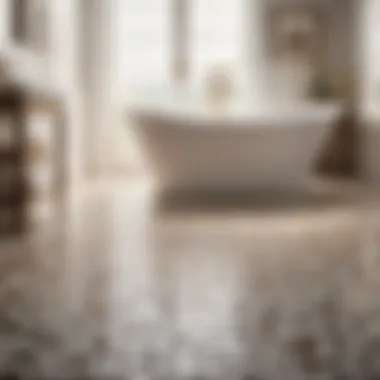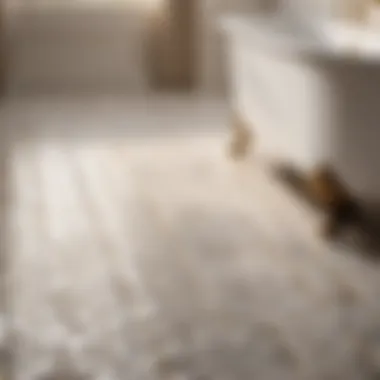Materials:
- Porcelain tiles (65 square feet)
- Ceramic tiles (65 square feet)
- Tile adhesive (3 bags)
- Grout (2 bags)
- Tile spacers (200 pieces)
- Water-resistant membrane
- Notched trowel
- Tile cutter
- Grout float
- Rubber mallet
- Sponge
- Bucket
DIY Steps:
-
Preparation: Measure the bathroom floor area and choose between porcelain and ceramic tiles based on desired characteristics.
-
Surface Preparation: Ensure the floor is clean, dry, and level before starting the tiling process.
-
Applying Membrane: Apply a water-resistant membrane to protect the subfloor from moisture.
-
Tile Layout: Plan the layout of the tiles to achieve the desired pattern and aesthetics.
-
Tile Installation: Begin by spreading tile adhesive with a notched trowel and lay the tiles using spacers for consistent spacing.
-
Grouting: After the adhesive has dried, fill the gaps between tiles with grout using a grout float.
-
Finishing Touches: Clean off excess grout with a damp sponge and allow the tiles to set before walking on the floor.
Technical Aspects:
-
Tools: Ensure you have a tile cutter, rubber mallet, and other necessary tools for precise tile cutting and installation.
-
Timing Specifics: Allow for drying time between laying tiles and grouting to achieve a durable finish.
-
Key Techniques: Use spacers for even tile placement, apply even pressure when setting tiles, and clean grout lines thoroughly for a polished look.
DIY Project Process:


-
Installation Method: Follow the steps provided above for a successful tile installation process.
-
Troubleshooting Tips:
- If tiles are not aligning correctly, adjust them before the adhesive sets completely.
- Smooth out uneven grout lines with a grout float for a professional finish.
Introduction


In the realm of bathroom flooring, the choice between porcelain and ceramic tiles holds significant weight. The decision you make can impact the functionality, durability, and aesthetic appeal of your space. This article aims to provide a detailed comparison between porcelain and ceramic tiles, delving into their material composition, maintenance requirements, and cost-effectiveness. By dissecting these crucial factors, readers will be equipped to make an informed decision about the ideal tiling option for their bathroom floors.
Overview of Porcelain and Ceramic Tiles


Composition and Manufacturing Process
The Composition and Manufacturing Process of porcelain and ceramic tiles play a pivotal role in determining their characteristics. Porcelain tiles are crafted using a dense clay mixture fired at higher temperatures, making them incredibly durable and water-resistant. On the other hand, ceramic tiles consist of a combination of clay, sand, and other natural materials, kiln-fired at lower temperatures. This distinction results in porcelain tiles being harder and less porous than ceramic tiles, rendering them more suitable for areas prone to moisture and heavy foot traffic.
Key Differences in Properties
The key differences in properties between porcelain and ceramic tiles lie in their water absorption rates, density, and durability. Porcelain tiles exhibit lower water absorption rates, making them impervious to moisture penetration and ideal for wet areas like bathrooms. Moreover, their denser composition enhances their durability and resistance to scratches and stains compared to ceramic tiles. While ceramic tiles are more budget-friendly, their higher water absorption rates and lower density make them better suited for lighter foot traffic areas.
Importance of Choosing the Right Tile for Bathroom Floors
Water Resistance
Water resistance is a critical factor when selecting tiles for bathroom floors. Porcelain tiles excel in this aspect due to their low water absorption rate, preventing water damage and mold growth. This feature enhances the longevity of the tiles and ensures a hygienic bathroom environment. In contrast, ceramic tiles, with their higher water absorption rates, may experience warping and discoloration over time, necessitating more maintenance to preserve their appearance.
Durability
When it comes to durability, porcelain tiles outshine ceramic tiles due to their dense composition and hardness. Porcelain tiles are more resilient to cracking, chipping, and wear, making them a long-lasting choice for high-traffic areas. Ceramic tiles, while durable, are more prone to damage from impact and heavy use, requiring more frequent replacements to maintain the floor's integrity.
Aesthetics
Aesthetically, both porcelain and ceramic tiles offer a myriad of design options to enhance the visual appeal of your bathroom. Porcelain tiles replicate the look of natural stone or wood with remarkable accuracy, adding a touch of elegance to the space. On the other hand, ceramic tiles come in diverse colors, patterns, and textures, allowing for creative customization. Whether you prefer a sleek, modern aesthetic or a warm, textured finish, both tile types offer versatile options to complement your bathroom decor.
Porcelain Tiles
Porcelain tiles play a crucial role in the discussion of Porcelain vs Ceramic Tiles for Bathroom Floors within this comprehensive guide. Highlighting specific elements and considerations about Porcelain Tiles is essential for readers to make informed decisions when selecting the ideal tiling option for their bathroom space.
Characteristics of Porcelain Tiles
Density and Durability
When delving into the characteristics of Porcelain Tiles, the density and durability standout as key features essential to their appeal. Porcelain tiles are known for their high density, contributing to exceptional durability that ensures longevity and resistance against wear and tear, making them perfect for high-traffic areas such as bathroom floors. This unique feature makes Porcelain Tiles a popular choice for homeowners looking for a long-lasting and robust tiling solution for their bathrooms.
Water Absorption Rate
The water absorption rate of Porcelain Tiles is a significant aspect to consider when comparing tiling options. With a low water absorption rate, Porcelain Tiles exhibit excellent resistance to moisture, preventing water damage and mold growth in bathroom environments. This characteristic enhances the longevity and durability of the tiles, making them a favorable choice for maintaining a pristine bathroom floor over time.
Scratch and Stain Resistance
Scratch and stain resistance are distinctive features of Porcelain Tiles that contribute to their overall appeal. Porcelain Tiles' high resistance to scratches and stains ensures they retain their aesthetic appeal and smooth surface texture, even in high-traffic areas like bathrooms. This unique feature reduces maintenance requirements and prolongs the tiles' pristine appearance, highlighting their suitability for bathroom floors that require easy upkeep.
Pros of Using Porcelain Tiles for Bathroom Floors
Longevity
The longevity of Porcelain Tiles is a standout feature that makes them a preferred choice for bathroom floors. Their durable nature and resistance to wear ensure that Porcelain Tiles maintain their pristine appearance even after years of use, reducing the need for frequent replacements and providing long-term cost-effectiveness for homeowners.
Low Maintenance
Porcelain Tiles' low maintenance requirements make them a practical choice for busy homeowners seeking easy-to-care-for tiling options. Their resistance to scratches, stains, and water damage simplifies cleaning, requiring minimal effort to keep the bathroom floor looking impeccable. This low-maintenance characteristic adds convenience and efficiency to the care routine for Porcelain Tile floors.
Wide Range of Design Options
Porcelain Tiles offer a wide range of design options, allowing homeowners to personalize their bathroom floors to match their style preferences seamlessly. From various colors, patterns, and textures to mimic natural stone or wood finishes, Porcelain Tiles provide versatility in design choices, enabling homeowners to create a customized and aesthetically pleasing bathroom space tailored to their unique tastes.
Cons of Using Porcelain Tiles
Installation Difficulty
One of the potential drawbacks of using Porcelain Tiles for bathroom floors is the installation difficulty they may present. Due to their dense and heavy nature, Porcelain Tiles can be challenging to cut and install, requiring professional expertise and specialized tools for a flawless finish. While the installation process may be more complex compared to ceramic tiles, the end result justifies the effort for homeowners seeking long-term durability and visual appeal.
Higher Cost
The higher cost of Porcelain Tiles compared to other tiling options is a factor that homeowners need to consider when planning their bathroom renovation projects. Porcelain Tiles generally come at a higher price point due to their exceptional quality, durability, and design versatility. Despite the initial investment, the long-term benefits of Porcelain Tiles, such as longevity and reduced maintenance, make them a worthwhile investment for homeowners looking for premium tiling solutions for their bathroom floors.
Ceramic Tiles
When it comes to choosing the right flooring for your bathroom, ceramic tiles play a crucial role. These tiles offer a blend of functionality and aesthetics that make them a popular choice among homeowners. Ceramic tiles are known for their versatility, durability, and ease of maintenance, making them a practical option for bathroom floors.
Characteristics of Ceramic Tiles
Composition and Texture
The composition and texture of ceramic tiles are key defining factors that set them apart in the world of flooring options. Ceramic tiles are made from a mixture of clay, minerals, and water, which are then kiln-fired to create a hard surface. This manufacturing process results in tiles that are strong, resistant to wear and tear, and relatively easy to clean. The texture of ceramic tiles can vary, offering choices such as glossy, matte, or textured finishes to suit different aesthetic preferences. The composition and texture of ceramic tiles contribute to their overall durability and appeal, making them a popular choice for bathroom floors.
Durability Factors
Durability is a significant factor to consider when selecting bathroom flooring, and ceramic tiles excel in this regard. Ceramic tiles are inherently durable and resistant to scratches, stains, and moisture, making them ideal for high-traffic areas like bathrooms. Their sturdy composition ensures that ceramic tiles maintain their quality and appearance over time, providing a long-lasting flooring solution for homeowners.
Water Absorption Rate
One of the standout features of ceramic tiles is their low water absorption rate. This characteristic makes ceramic tiles water-resistant, ensuring that they are not easily degraded by moisture. The low water absorption rate of ceramic tiles also makes them less prone to mold or mildew growth, enhancing the hygiene and longevity of your bathroom flooring. With this quality, ceramic tiles offer a practical and reliable option for moisture-prone areas like bathrooms.
Advantages of Using Ceramic Tiles for Bathroom Floors
Affordability
Ceramic tiles are a cost-effective flooring option for bathroom floors. Their relatively low production cost compared to other types of tiles makes them a budget-friendly choice for homeowners looking to renovate their bathrooms without breaking the bank. Despite their affordability, ceramic tiles do not compromise on quality, offering a durable and stylish flooring solution at a reasonable price point.
Ease of Installation
The ease of installation is a significant advantage of ceramic tiles. These tiles are comparatively lighter than other flooring materials, making them easier to handle and install. Homeowners with DIY skills can consider laying ceramic tiles themselves, saving on installation costs. Additionally, the straightforward installation process of ceramic tiles ensures a quicker renovation timeline, allowing you to enjoy your new bathroom flooring in no time.
Variety of Styles
Ceramic tiles come in a wide array of styles, colors, and patterns, providing homeowners with a diverse range of design options to choose from. Whether you prefer a classic, modern, or eclectic look for your bathroom, ceramic tiles offer versatility in design to suit various aesthetic preferences. From sleek monochromatic tiles to bold geometric patterns, the variety of styles available in ceramic tiles allows you to customize your bathroom flooring to reflect your personal style and taste.
Disadvantages of Using Ceramic Tiles
Durability Concerns
While ceramic tiles are generally durable, they are susceptible to cracking or chipping under heavy impact. Sharp objects dropped on ceramic tile floors can cause damage, requiring replacements or repairs. Additionally, the grout lines between ceramic tiles may accumulate dirt and grime over time, impacting the overall appearance of the flooring. To mitigate durability concerns, proper care and maintenance are essential to preserve the integrity of ceramic tile floors.
Maintenance Challenges
The grout lines of ceramic tiles pose a maintenance challenge, as they require regular cleaning to prevent discoloration or mold growth. Maintaining the cleanliness of grout can be a tedious task, involving scrubbing and sealing to keep the tiles looking fresh and vibrant. Additionally, ceramic tiles may require resealing to protect against moisture infiltration and maintain their water-resistant properties. Despite these maintenance challenges, the enduring beauty and functionality of ceramic tiles make them a popular choice for bathroom floors with proper upkeep.
Choosing the Right Tile for Your Bathroom Floor
Selecting the appropriate tile for your bathroom floor is a crucial decision that encompasses various essential factors impacting not only the aesthetic appeal but also the functionality and longevity of the flooring. In this article, we delve into the intricate details of ensuring that your choice aligns perfectly with your needs and preferences, offering a seamless blend of durability, style, and practicality for your bathroom space.
Factors to Consider
Budget
When considering the ideal tile for your bathroom floor, budget stands out as a fundamental aspect that directly influences your options. Your budget not only determines the type of tile you can afford but also dictates the overall quality and design choices available to you. Understanding the financial constraints and allocating resources effectively can lead to a well-informed decision that balances cost-efficiency with quality and durability.
Expected Foot Traffic
Another critical element in selecting the right tile for your bathroom floor is evaluating the expected foot traffic in the space. High-traffic bathrooms require tiles that can withstand frequent use without showing signs of wear and tear too quickly. By analyzing the typical usage patterns, you can choose a tile that offers the necessary durability and resilience to maintain its appearance and structural integrity over time.
Design Preferences
Considering your design preferences is paramount in creating a cohesive and visually appealing bathroom environment. From choosing between sleek modern designs to timeless classic styles, your personal taste plays a significant role in determining the overall aesthetic of your bathroom floor. By aligning your design preferences with the practical aspects of the tile, such as color, texture, and pattern, you can achieve a harmonious balance between visual allure and functional utility.
Professional Recommendations
Consultation with Tile Experts
Seeking advice from tile experts can provide invaluable insights and recommendations tailored to your specific requirements and concerns. Professional consultation offers a personalized approach to selecting the most suitable tile for your bathroom floor, taking into account factors like moisture levels, installation complexities, and maintenance considerations. By leveraging the expertise of professionals, you can navigate the myriad options available in the market with confidence and clarity, ensuring a successful and satisfying tile selection process.
Site-Specific Considerations
Taking into consideration the unique characteristics of your bathroom space is essential for choosing the right tile that complements the existing layout and design elements. Site-specific considerations encompass factors such as room size, lighting conditions, layout configurations, and existing decor, all of which influence the optimal tile choice for your bathroom floor. By evaluating these site-specific nuances, you can make an informed decision that aligns with the spatial dynamics and aesthetic nuances of your bathroom, ensuring a cohesive and visually cohesive flooring solution.
Conclusion
In the realm of tile selection for bathroom floors, the decision between porcelain and ceramic tiles holds significant weight. This article meticulously dissected the key disparities in material composition, durability, maintenance requirements, aesthetic allure, and cost-effectiveness between these two prominent tiling options. By scrutinizing an array of factors, readers have undoubtedly gained an in-depth understanding of which tile type best suits their bathroom flooring prerequisites.
Final Thoughts on Porcelain vs Ceramic Tiles for Bathroom Floors
Summary of Variance
Unveiling the unique characteristics of porcelain and ceramic tiles sheds light on the variance that distinguishes these flooring materials. Porcelain, known for its superior density, exceptional durability, and minimal water absorption rate, stands out as a top-notch choice for those valuing longevity and resilience in their bathroom tiles. On the other end, ceramic tiles tout affordability, ease of installation, and a plethora of styles, making them an attractive option for those seeking versatility and budget-friendliness. Understanding the specific attributes of each type allows homeowners to make informed decisions tailored to their individual preferences and requirements.
Personalized Decision Making
The facet of personalized decision-making in tile selection emphasizes the importance of considering unique factors when choosing between porcelain and ceramic tiles for bathroom flooring. Tailoring the decision to factors such as budget constraints, expected foot traffic, and design preferences ensures that the chosen tile aligns harmoniously with the practical and aesthetic needs of the space. Consulting with tile experts and factoring in site-specific considerations further solidifies the decision-making process, enabling homeowners to embark on their renovation journey with confidence and clarity.





